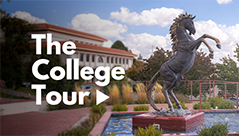WNMU was well represented at this year’s Border Archives Bazaar, held September 23 at the New Mexico Farm and Ranch Heritage Museum in Las Cruces, where both the J. Cloyd Miller Library and the WNMU Museum had table-top displays of the university’s archival treasures. Hosted by the Border Regional Archives Group, the event brings together resources from more than a dozen libraries, archives, and museums of the borderlands.
The library’s display was drawn from the Juan Chacón Collection, which focuses on organized labor and mining in southwest New Mexico as well as on the film “Salt of the Earth.” Librarian Andrea Jaquez said that in deciding what to feature from the library’s collection, she decided to focus on “what we are known for,” which is the Juan Chacón Collection and related materials connected to mining history and labor.
Jaquez noted that it is sometimes a challenge to present the library’s rich resources in a way that is visually engaging, as at an event like the bazaar, people are not necessarily going to stop to read long passages of text. Instead of solely focusing on books and papers, she brought together some of the more visually enticing items, such as a reproduction of the original poster advertising “Salt of the Earth,” photographs of some of the women that were involved in the strike against the Empire Zinc Mine, on which the movie is based, and satellite imagery of area mines.
Jaquez said that the purpose of the bazaar is to “get people in touch with history [and] let them know our history means something.”
She also sees it as a good way to let them know the wonderful resources that are available. “It is a way for all of the archives to be out there saying, ‘This is what we have. Come and look.’” The bazaar also helps archivists connect with each other and learn about the collections in the region. “It’s a networking tool for us.” She especially enjoys the opportunity to connect with others who have a passion for history.
WNMU Museum featured a sample of Mimbres pots from their collection, as well as some of the photographs and other historical material housed in the museum. “One of the things that I am really looking forward to is creating partnerships with other universities and institutions,” said WNMU Museum Director Danielle Romero. She said that she was especially excited to meet the curators and directors of the New Mexico Farm and Ranch Heritage Museum because some of the holdings in the WNMU Museum are related to farming and ranching, but are not currently on display. She planned “to see if we can partner through long-term loans between the institutions.”
In choosing items to display at the event, Romero explained, “I wanted to showcase what we have archive-wise, but we also wanted to represent what we generally do, so I chose to [create] three sections” of display: prehistoric materials, campus history, and other general historical materials. As part of the campus history display, Romero included a demonstration of the software DStretch, which is used by archeologists studying rock art to enhance pictographs that are invisible to the naked eye. Rather than using it on rock art, Romero has successfully used the software to enhance an otherwise illegible name on a WNMU diploma from the late nineteenth century. The bazaar offered an opportunity for Romero to share this new application both with fellow archivists and the general public.
The bazaar attracted not only historians and other archivists but also members of the general public that had an interest in southwestern history. One visitor, Joe Tellez, said that this was his second year attending the event. “There are so many resources that most people don’t know about,” Tellez said, “If you are interested in history like me, this is a good place to start.”



